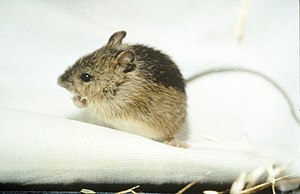Field Guide/Mammals/Meadow Jumping Mouse
< Field Guide | Mammals
| zapus hudsonius (Meadow Jumping Mouse) | |
|---|---|
|
Family: Dipodidae
Size: Meadow Jumping Mice range in length from 180 to 240 mm. The hind feet are 28 to 35 mm long.
Body weight typically depends on the time of year; they weigh more prior to hibernation,up to 35 g. During the summer, weights average between 16 and 19 g.[1]
Description: Meadow Jumping Mice are recognized by their extremely long tails, long hind feet, and slender build. Adults have a dorsal dark or olive brown band, which is paler in juveniles. The sides are a pale yellowish-brown, with black hairs lining the sides, and the underparts are white. The tail is sparsely haired, dark brown on top, and white on the bottom, and is longer than the body length. Meadow jumping mice are the only mammal with eighteen teeth. The upper jaw is characterized as having short, narrow, and longitudinally grooved incisors; small cheek teeth; and a small premoloar that generally precedes the molars.
Similar Species: The Meadow Mouse is similar in appearance to the Woodland Jumping Mouse except they do not have a white-tipped tail and are typically duller in color.
Range: This species is found throughout northern North America.They are found as far North as Alaska and as far south as New Mexico giving them the widest distribution of mice in the subfamily Zapodinae.[2]
Habitat: Meadow Jumping Mice live in various habitats that have some herbacious cover. They prefer moist grasslands and avoid heavily wooded areas. Grassy fields and thick vegetated areas bordering streams, ponds, or marshes generally support greater numbers of this species.[3]
Diet: Meadow Jumping Mice primarily eat seeds, but also feeds on fruit, insects, and berries.
Activity: Meadow Jumping Mice are solitary, but not aggressive toward others. They are generally nocturnal (although occasionally diurnal), and usually move in short hops of about 2.5 to 15 cm or by crawling along vole runways or in the grass. They are also great swimmers, diggers, and can climb. These mice are relatively nomadic, and may roam up to 1 km in search of moist habitat. They also hibernate during the winter.[4]
Reproduction: The breeding season of Meadow Jumping Mice occurs after hibernation in late April or May. Males emerge from hibernation slightly before the females and are reproductively active when the females emerge. Gestation is usually about 18 days, but may be longer for females who are already nursing a litter. Females typically have 2 to 3 litters in a year with an average of 5.3 young per litter. Small and weighing about 0.8 g, the neonates are naked, pink, blind, clawless and deaf, but squeak audibly at birth. In the first week, their ears unfold, fur begins to cover their backs, and their claws appear. They begin crawling between one and two weeks, and by the third week they can hop, creep, and hear. Their incisors have erupted, and they have tawny coats. By the end of the fourth week, the young have adult pelage, and open eyes. Weaned, they become independent during the 4th week.[5]
Lifespan: <1 year in the wild, or up to 5 years in captivity
Notes: The Meadow jumping mouse can jump up to 3 feet in length in its first jump which it then follows with a series of smaller jumps.
|
 |
- ↑ Template:Citation Smithl
- ↑ Whittakerl, J.O. (1972), "Zapus Hudsonius" (PDF), Mammalian Species, no. 189, pp. 1–7, retrieved October 10, 2012
- ↑ Whittakerl, J.O. (1972), "Zapus Hudsonius" (PDF), Mammalian Species, no. 189, pp. 1–7, retrieved October 10, 2012
- ↑ "Meadow Jumping Mouse", Mammals of Minnesota, pp. 106–109., 1982
{{citation}}:|first1=missing|last1=(help); Text "last1Hazardl" ignored (help) - ↑ "Meadow Jumping Mouse", Mammals of Minnesota, pp. 106–109., 1982
{{citation}}:|first1=missing|last1=(help); Text "last1Hazardl" ignored (help)